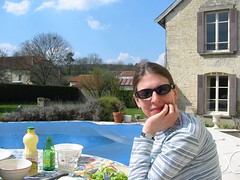
Not many people know about the annual Historic Reims Monte-Carlo car rally. Even fewer know that pretty much every year it passes through our village, so only the Mayor and one of the local farmers were there when Jonathan and I pitched up on the bend by the Mairie just after 10pm last Friday.
It’s only by chance that we know about it. We were sitting in the front room one evening at the end of our first January in residence a couple of years ago when we realised there was an astonishing amount of very loud traffic going by for a late Friday evening. More than likely we were huddled up on the sofa wrapped up in blankets as that was before we had the wood-burner installed. It was a snowy night and neither of us could be bothered to leave our snug spot to go and have a look outside - one disadvantage of shutters is that they stop you sticking your nose through the curtains to see what’s going on. We just put it down to the local youths, who are usually pretty inaudible, being noisy for a change.
The next day the local paper filled us in. The town of Langres, about 50 minutes south of us, is one of the rally control points so the correspondent there could take pictures (much easier when the cars aren’t moving) and talk to some of the drivers, especially the ones from around here. It’s always been a mystery to me why the Journal of the Haute-Marne keeps so many events secret until after they’ve happened. Anyway, this belated coverage enabled us to find more details on the web and we realised that we’d missed the sight of old Porches and Ford Capris, among others, skidding in the snow on the D6 as it makes a wide curve round the Mairie.
After missing last year’s rally because of events back in England, we were determined to take a look this year and Jonathan was equally determined to take a few pictures. Just after ten pm we heard the window-rattling, throaty roar of the first cars picking up speed as they got round the bend just beyond our gates. That was our signal to don several layers of fleece, hats and gloves and head down the road. Circé very wisely decided that it wasn’t worth the effort.
It took a while for Jonathan to get the hang of photographing moving objects in the dark (the street lights in the village go off at the end of the evening) but after a few attempts he really got the hang of it and we’re both pleased with the results.
As the 127 competitors had left Reims in batches, watching an event like this is the polar opposite of the Tour de France. In that case you wait ages, being kept amused by the so-called ‘caravan’ and then, if you’re lucky, the front runners have separated from the péloton, so you get a good look at them before everyone else whizzes past in the space of 10 seconds.
Most of the cars on Friday night went past on their own or in ones and twos so Jonathan usually had plenty of time to cue up the camera, especially as they could be heard long before we could see their headlights. Seeing the camera and the little band of unexpected spectators, most drivers took their foot off the accelerator and flashed their lights. As you can see from the pictures, some even waved. They probably thought we were waving and jumping up and down because this was the most exciting thing that’s happened in Cirfontaines in a while. That might be true, but the fact is that it was well below zero and I for one had only put on one pair of socks, and I’m sure the other spectator was wearing his slippers.
While Jonathan adjusted important camera settings in between cars, there was plenty of time for me to chew the cud with our fellow-spectator (the Mayor having decided to call it a day at about 10.30). Among other things we talked about septic tanks, the wild boar population explosion, and, inevitably, how much better life is here than anywhere else. Every now and then we admired the latest fruits of Jonathan’s labours.
Just after midnight the cold finally got the better of us and as the gaps between cars was getting longer we decided to head home. It was quite a surprise to me how much I enjoyed myself. We’ll certainly try and do the same thing next year, hopefully encouraging a few more people to join in. What’s certain, though, is that I’ll be wearing at least two pairs of socks!
In the meantime, we’ve got even more sport to look forward to. Stage 12 of this year’s Tour de France is passing very close to us.



